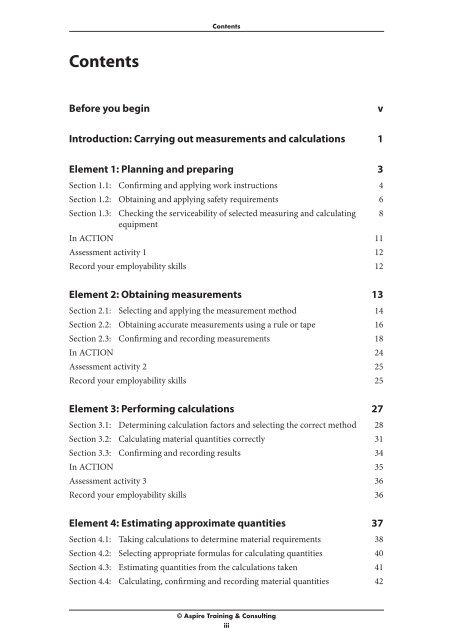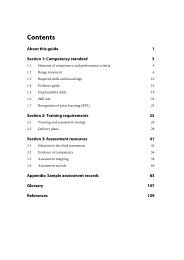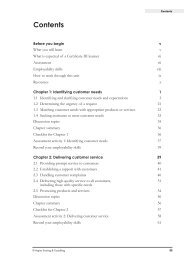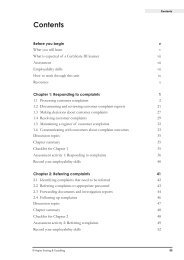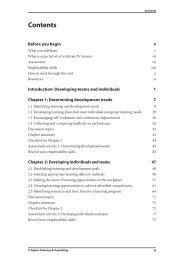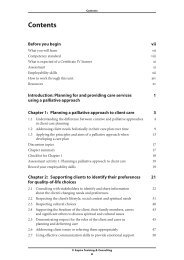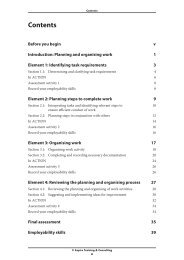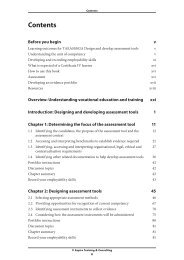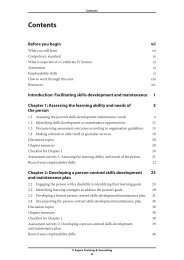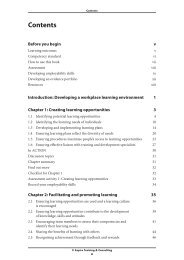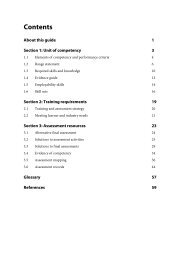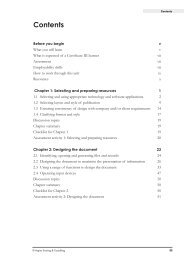CPCCCM1015A Carry out measurements and calculations
CPCCCM1015A Carry out measurements and calculations
CPCCCM1015A Carry out measurements and calculations
You also want an ePaper? Increase the reach of your titles
YUMPU automatically turns print PDFs into web optimized ePapers that Google loves.
ContentsContentsBefore you beginvIntroduction: <strong>Carry</strong>ing <strong>out</strong> <strong>measurements</strong> <strong>and</strong> <strong>calculations</strong> 1Element 1: Planning <strong>and</strong> preparing 3Section 1.1: Confirming <strong>and</strong> applying work instructions 4Section 1.2: Obtaining <strong>and</strong> applying safety requirements 6Section 1.3: Checking the serviceability of selected measuring <strong>and</strong> calculating 8equipmentIn ACTION 11Assessment activity 1 12Record your employability skills 12Element 2: Obtaining <strong>measurements</strong> 13Section 2.1: Selecting <strong>and</strong> applying the measurement method 14Section 2.2: Obtaining accurate <strong>measurements</strong> using a rule or tape 16Section 2.3: Confirming <strong>and</strong> recording <strong>measurements</strong> 18In ACTION 24Assessment activity 2 25Record your employability skills 25Element 3: Performing <strong>calculations</strong> 27Section 3.1: Determining calculation factors <strong>and</strong> selecting the correct method 28Section 3.2: Calculating material quantities correctly 31Section 3.3: Confirming <strong>and</strong> recording results 34In ACTION 35Assessment activity 3 36Record your employability skills 36Element 4: Estimating approximate quantities 37Section 4.1: Taking <strong>calculations</strong> to determine material requirements 38Section 4.2: Selecting appropriate formulas for calculating quantities 40Section 4.3: Estimating quantities from the <strong>calculations</strong> taken 41Section 4.4: Calculating, confirming <strong>and</strong> recording material quantities 42© Aspire Training & Consultingiii
ContentsIn ACTION 44Assessment activity 4 45Record your employability skills 45Final assessment 47Employability skills 51© Aspire Training & Consultingiv
Element 1: Planning <strong>and</strong> preparingElement 1:Planning <strong>and</strong> preparingOverviewPlanning <strong>and</strong> preparing for tasks includes confirming instructions, identifying anysafety requirements <strong>and</strong> selecting the correct equipment for measuring <strong>and</strong> calculatingmaterials.During the planning <strong>and</strong> preparation stage of any activity it is essential to consider allaspects of the task. This may include the task requirements, communication requirements,safety requirements, equipment requirements <strong>and</strong> the material requirements.Before starting to take <strong>measurements</strong> or make <strong>calculations</strong>, you should always checkthe equipment you will be using for serviceability <strong>and</strong> suitability for the tasks. Duringthe entire measuring <strong>and</strong> <strong>calculations</strong> phase of a task, you should always remember‘measure twice, cut once’. This adage is just as relevant with <strong>calculations</strong>, ‘calculatetwice, order once’. This approach ensures you measure, calculate <strong>and</strong> complete the tasksefficiently <strong>and</strong> effectively <strong>and</strong> avoid making mistakes that will lead to wasted time,money or materials.Learning <strong>out</strong>comesYou need to demonstrate competency in the following areas:Section 1.1Section 1.2Section 1.3Confirming <strong>and</strong> applying work instructionsObtaining <strong>and</strong> applying safety requirementsChecking the serviceability of selected measuring <strong>and</strong> calculatingequipment© Aspire Training & Consulting3
<strong>CPCCCM1015A</strong> <strong>Carry</strong> <strong>out</strong> <strong>measurements</strong> <strong>and</strong> <strong>calculations</strong>Section 1.1:Confirming <strong>and</strong> applying workinstructionsAt the start of any activity or task it is important to confirm the work instructions.Instructions may be given to you verbally or in written form. Checking instructionscan be done in a number of ways but questioning the person who has given you theinstruction is the easiest. Other ways could include checking workplace procedures,company policies, plans or specifications.All tasks undertaken in the construction industry should have a variety of documentationthat can be used to confirm <strong>and</strong> apply work instructions, including:• diagrams, sketches, maps, signs, plans• instructions from internal or external personnel• manufacturer specifications <strong>and</strong> instructions• safety data sheets (SDSs)• the organisation’s work specifications, procedures <strong>and</strong> policies• regulatory <strong>and</strong> legislative requirements, <strong>and</strong> Australian st<strong>and</strong>ards• safe work method statements (SWMSs) or procedures, job safety analysis sheets (JSAs)• work bulletins, memos or schedules.Copies of these documents can be found in the siteoffice or the organisation’s main office. Most of thisinformation will be included in your workplacepolicies <strong>and</strong> procedures. Everyone at the worksiteneeds to read, underst<strong>and</strong> <strong>and</strong> follow the workplacepolicies <strong>and</strong> procedures to ensure all work is donesafely <strong>and</strong> effectively.Once you have confirmed the instructions <strong>and</strong> are aware of the requirements for thetask, you can then do what has been asked of you.Find <strong>out</strong> moreProduction MachiningResourceThe reason for work instructionswww.productionmachining.com/articles/the-reasonfor-work-instructions.aspxMonash University (VIC)Safe work instructions – workshop safetywww.monash.edu.au/ohs/topics/safe-work.htmlWhy it is usefulThis web article explains the purpose ofdocumented work instructions.This web page provides a simpleexplanation of safe work procedures <strong>and</strong>the type of information they contain.© Aspire Training & Consulting4
Element 2: Obtaining <strong>measurements</strong>It is necessary to know the units of measure for the worksite. The general practice inconstruction is to use the metric system <strong>and</strong> give <strong>measurements</strong> for length, width, heightor depth in millimetres (mm) <strong>and</strong> metres (m). For example, 2400 mm lengths of timber,100 mm PVC pipe, or a hole dug to 750 mm deep.All weights are given as kilograms (kg) or tonnes (t). For example,a 20 kg bag of cement or a 5 kg bag of lime. Litres (l) <strong>and</strong> millilitres(mL) are the <strong>measurements</strong> used for liquids such as water, paint,solvents <strong>and</strong> liquid chemicals.Sometimes the tool that you use to measure materials will havedirections for use from the manufacturer. In other cases, measuremethods may be detailed in workplace procedures or instructions.Ask your supervisor if you are in doubt ab<strong>out</strong> what tool or methodto use <strong>and</strong> the requirements for the work.Find <strong>out</strong> moreResourceLawler, G 2011, Underst<strong>and</strong>ing maths: basicmathematics explained, 3rd edn, AberPublishing, Australia.Centre for Innovation in Mathematics Teaching(UK)Measuring lengthswww.cimt.plym<strong>out</strong>h.ac.uk/projects/mepres/book7/bk7i19/bk7_19i1.htmWhy it is usefulThis book covers basic maths concepts foradults using day-to-day principles.This is from a UK website – this web pageexplains the concept of choosing the mostappropriate unit of length for measuringparticular things, <strong>and</strong> provides opportunities forpractice.Section task 2.1Find two methods of measurement used in construction. Briefly describe each one <strong>and</strong> how itis used.Method Description Purpose© Aspire Training & Consulting15
<strong>CPCCCM1015A</strong> <strong>Carry</strong> <strong>out</strong> <strong>measurements</strong> <strong>and</strong> <strong>calculations</strong>Section 2.2:Obtaining accurate <strong>measurements</strong>using a rule or tape‘Measure twice; cut once’ is a common phrase used when <strong>measurements</strong> are beingtaken. This ensures the accuracy of the <strong>measurements</strong> <strong>and</strong> reduces problems such asinsufficient materials or excess wastage.Measurements taken on construction sites are often done with measuring rules or tapes.These <strong>measurements</strong> are generally for objects of relatively small dimensions up to onlya few metres. It is important to know the correct measurement device to use for theintended purpose that may include measuring <strong>out</strong> materials, site dimensions or otherbasic activities.It is important to make sure that the measuring toolis capable of reading to the appropriate st<strong>and</strong>ard. Ifthe job requires <strong>measurements</strong> in millimetres, makesure the tape or ruler has markings suitable to thetask. There is no point using a tape that is marked inmetres, if you need a result in millimetres.In one metre, there are 1000 millimetres (1 m = 1000mm), so if the wrong measuring device is used in thefirst place, there is a high margin for error.Most modern tapes <strong>and</strong> rules have markings in millimetres. It is important to checkthe piece of equipment before you start. Construction st<strong>and</strong>ards require metric<strong>measurements</strong> in line with the job specifications.Imperial <strong>measurements</strong> (using feet <strong>and</strong> inches) are not to be used. If necessary,<strong>measurements</strong> given in imperial format MUST be converted to metric before startingthe task. Various conversion tables are available but in Australia, most <strong>measurements</strong>are already in metric form.You have to know how to convert the units to meet the requirements for the tasks youare doing. Some common conversions include the following:Conversion Calculation ExampleMetres to millimetres Multiply the number by 1000 1.5 m × 1000 = 1500 mmMillimetres to metres Divide the number by 1000 2750 mm ÷ 1000 = 2.75 mAccuracy in measuring is important. One way to do this is to reduce the possibility oferror when measuring. One of the most common errors is when the eye is not in linewith the object being measured. This is shown in the following diagram.© Aspire Training & Consulting16
Element 2: Obtaining <strong>measurements</strong>(Reproduced with permission of © Five Star Safety <strong>and</strong> Training 2009.)Once you have one or a series of <strong>measurements</strong>, these may then need to be used forvarious <strong>calculations</strong> for area, volume, quantity, cost or other worksite factors. Some ofthese <strong>calculations</strong> are explained in more detail in following sections of this unit.It is important to get help if you don’t underst<strong>and</strong> or need assistance with <strong>measurements</strong>.You do not have to be an expert at maths to work in construction but you do need to knowhow to work <strong>out</strong> <strong>measurements</strong> <strong>and</strong> <strong>calculations</strong> that may apply to your workplace.Find <strong>out</strong> moreeHowAb<strong>out</strong> metric rulersResourcewww.ehow.com/ab<strong>out</strong>_4707326_metric-rulers.htmleHowHow to use a metric tape measurewww.ehow.com/how_2294327_use-metrictape-measure.htmlWhy it is usefulThis is from a US website – this web pagedescribes the use of metric rulers to measureobjects.This is from a US website – this web pagedescribes how to use a metric tape measure.Section task 2.21. Briefly describe why you should use a ruler or tape in millimetres for construction<strong>measurements</strong>.2. List two types of errors that can occur when measuring an object.© Aspire Training & Consulting17
<strong>CPCCCM1015A</strong> <strong>Carry</strong> <strong>out</strong> <strong>measurements</strong> <strong>and</strong> <strong>calculations</strong>In ACTIONPhil’s storyAs a new worker to the construction industry, Phil speaksto his team leader Jake ab<strong>out</strong> the various <strong>measurements</strong>he may be required to do in the worksite. Jake explainswhat is required <strong>and</strong> what methods are used on the site.He suggests Phil take some time to practise doing somecommon <strong>measurements</strong> to familiarise himself with theprocedures <strong>and</strong> materials.Phil uses a tape measure to take some simple <strong>measurements</strong>,then uses his <strong>measurements</strong> in various formulas that arerelevant to the construction activities. He then confirms his results with Jake to ensure that he hascompleted the tasks correctly. Jake shows Phil how to record the results on the job sheet.Revision• The correct method for measurement must be selected <strong>and</strong> then applied to therelevant workplace activities.• Measurements using a tape measure or ruler are common in constructionactivities.• Measurements must be accurate, in metric format, <strong>and</strong> in line with the requirementsof the work. A tool that has the correct measurement markings (for example, inmillimetres) is required, <strong>and</strong> workers must be able to read the <strong>measurements</strong> to thenearest millimetre.• Measurements should be confirmed, checked <strong>and</strong> then recorded using theappropriate workplace procedures.Are you ready?Use this checklist to assess if you are ready for assessment activity 2.I underst<strong>and</strong> how to: Select <strong>and</strong> apply the measurement method Obtain accurate <strong>measurements</strong> using a rule or tape Confirm <strong>and</strong> record <strong>measurements</strong>© Aspire Training & Consulting24
Element 2: Obtaining <strong>measurements</strong>Assessment activity 2Obtaining <strong>measurements</strong>The following table maps the assessment activity for this chapter against the element<strong>and</strong> performance criteria of Element 2 in <strong>CPCCCM1015A</strong> <strong>Carry</strong> <strong>out</strong> <strong>measurements</strong> <strong>and</strong><strong>calculations</strong>.Part Element Performance criteriaWhole activity 2 2.1, 2.2, 2.31. Briefly describe why it is necessary to use the correct measurement method forconstruction activities.2. List two errors that could occur with <strong>measurements</strong>.3. Briefly explain how you could overcome these errors.4. List two types of <strong>measurements</strong> that may be found on a construction site.5. Write a sentence to explain why it is important to confirm <strong>and</strong> record<strong>measurements</strong>.6. List the formulas that you would use to calculate the following:ObjectFormulaArea of a rectangleArea of a circleVolume of a cylinderVolume of a rectangular prism or cubeArea of a triangleRecord your employability skillsWhen you have completed the assessment activity, make sure you record theemployability skills you have developed in the table at the end of the learner guide. Keepcopies of material you have prepared as further evidence of your skills.© Aspire Training & Consulting25
<strong>CPCCCM1015A</strong> <strong>Carry</strong> <strong>out</strong> <strong>measurements</strong> <strong>and</strong> <strong>calculations</strong>Section 3.1:Determining calculation factors <strong>and</strong>selecting the correct methodOnce the <strong>measurements</strong> have been taken <strong>and</strong> recorded, it may be necessary to includethese in formulas to carry <strong>out</strong> a further process. The methods <strong>and</strong> calculation factorsinvolved often depend on the work procedures <strong>and</strong> processes used.The type of work you are involved in determines the type of calculation that is required.These <strong>calculations</strong> may include:CapacityLength,Length,width, heightor depthWeight <strong>and</strong>mass massPerimeterArea <strong>and</strong>volumeCalculationfactorsFactorsMaterialquantitiesScalesAddition,subtraction,multiplicationmultiplication<strong>and</strong> division<strong>and</strong> divisionSlope <strong>and</strong>gradeFractions,Fractions,ratios <strong>and</strong>percentages(Reproduced with permission of © Five Star Safety <strong>and</strong> Training 2009.)Often these may be worked <strong>out</strong> using a calculator or through the use of manualmethods. You need to underst<strong>and</strong> the following important terms to help you determine<strong>measurements</strong> <strong>and</strong> <strong>calculations</strong>.ScaleScale is used to interpret dimensions from plans or drawings to full distance. Forexample, plans may be drawn to scale 1:100. This means that every 1 cm measured onthe plan equates to 100 cm measurement in reality.© Aspire Training & Consulting28
Element 3: Performing <strong>calculations</strong>PercentagesPercentage means <strong>out</strong> of one hundred. Percentages areused on construction sites to:• calculate <strong>and</strong> estimate quantities• calculate wastage• work with customer invoices, quotations <strong>and</strong>accounts• determine discounts• work <strong>out</strong> goods <strong>and</strong> services tax (GST).Percentages can be worked <strong>out</strong> manually or with a calculator. Consider the followingexample.1. Manually calculating a percentage:Example• Find the 10% discount on timber that costs $20.00• First you need to find 10% of $20.00, which is also expressed as 10% x $20.00; thecalculation is:10100 x 20 1200, which is the same as = , which equals $2.00.100• Therefore, there is a $2.00 discount.• So, $20.00 – $2.00 is $18.00, which is the discounted price of the timber.2. Using a calculator:• You can simply use the percentage button on the calculator:20 – 10%• The answer is 18.Slope or gradeIn some construction jobs it is necessary to calculate the slope of the ground or drainagelines. Slope can be defined as Rise ÷ Run. For example, if a site required slope to drainthe water away over a 10 m distance with a height of 300 mm (0.3 m).Slope = 0.3 m = 0.03, this equates to a 3% slope for the ground10 m0.3 m(rise)slopeCapacity10 m (run)Capacity is similar to volume but it is generally used to determine the size of thecontainer. For example, a 200 litre fuel drum, a 10 tonne tipping truck, 2 cubic metrebin. The term is used to indicate the maximum holding capacity of the object.© Aspire Training & Consulting29
<strong>CPCCCM1015A</strong> <strong>Carry</strong> <strong>out</strong> <strong>measurements</strong> <strong>and</strong> <strong>calculations</strong>Section 4.2:Selecting appropriate formulas forcalculating quantitiesFormulas are used to calculate quantities or material requirements on construction sites.Different worksites may use different formulas depending on the type of activities beingundertaken. For example, a plumber may use slightly different formulas to a bricklayeror a carpenter.Formulas may be used for areas, volumes, quantities, costs, quotations or other workplacefunctions. It is important that the correct formula is used for the intended function.Refer to Elements 2 <strong>and</strong> 3 for related formulas <strong>and</strong> information.Using the appropriate workplace checklists, forms or record sheets often makes the taskeasier. Workers should make themselves familiar with the relevant workplace procedures<strong>and</strong> systems where these relate to <strong>calculations</strong> <strong>and</strong> formulas.Using the right formula makes the job easier <strong>and</strong> more effective.It may also save the organisation time <strong>and</strong> money with reducedwaste <strong>and</strong> the supply of the required material quantities.Selecting the correct formula is often gained with practise. Themore you use the formulas, the easier it becomes to apply theformulas to other tasks. If you are not sure ab<strong>out</strong> the correctformula to use, speak to your supervisor for assistance. If this isan area that you have difficulty in, consider completing a trainingcourse to improve your skills.Find <strong>out</strong> moreResourceCommonwealth of AustraliaConstruction, utilities <strong>and</strong> telecommunicationsnumeracy programwww.dest.gov.au/archive/ty/litnet/numeracy/ncut.htmMeans, RS 1999, Means illustratedconstruction dictionary, RS Means Company,Massachusetts, USA.Why it is usefulThis website provides information on measuring,calculating <strong>and</strong> using formulas. It also providesexercises for the learner to complete.This book provides information on constructionterms, phrases, symbols, weights, measures,<strong>calculations</strong> <strong>and</strong> formulas.Section task 4.21. List three formulas used in a construction workplace.2. Write a sentence to describe why it is important to use formulas to give the correct results.© Aspire Training & Consulting40


